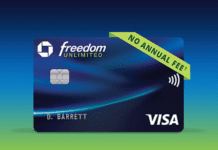NOTICE: This post references card features that have changed, expired, or are not currently available
Yesterday, I republished our post about the new offers on the Chase Freedom and Chase Freedom Unlimited cards because I verified that a double dip works at Whole Foods — that is to say that you can earn both the Freedom card’s quarterly bonus and the card’s first-year grocery bonus at the same time on a single purchase for a total of 9x. In response to that update, a reader asked if I hadn’t messed up and cost myself some extra rewards. In fact, I didn’t mess up, but I can see why the reader thought I did. In this post, I wanted to explain why I double dipped and why it is a net better deal than it may appear so that you can better compare bonus and base earnings on future purchases on any cards (not just those issued by Chase).
Bonus points vs base points
The key to following the math on this question is recognizing the difference between base points and bonus points. Bonus points are obvious when they are part of a big welcome bonus (i.e. Spend $4K, get 60K bonus points — in a situation like that, all 60K points are usually bonus points on top of what you earn for the $4K spend).
However, it’s easier to forget the difference between bonus and base when looking at category bonuses. All rewards credit cards have a base earn rate. Some have bonus categories that add something on top of the base earn.
For instance, most readers probably know that the Amex Gold card offers 4x Membership Rewards points at restaurants. The card ordinarily earns 1x on everyday purchases. The “bonus” for restaurants is an extra 3 points per dollar.
The same logic applies on a Chase Freedom card. The Freedom card offers rotating quarterly bonus categories that earn 5x total on up to $1500 in spend. It’s important to remember that you don’t earn 5x bonus points. The Freedom card’s base earning rate is 1x, so you would ordinarily earn 1500 points on $1500 in spend. The quarterly bonus is actually 6,000 bonus points on top of that.
This chart illustrates the breakdown of earnings in a quarterly bonus category:
| Card | Spend (in quarterly bonus category) | Base earn rate | Base points earned | Quarterly bonus rate | Quarterly bonus points earned | Total points earned |
| Freedom | $1500 | 1x | 1,500 | 4x | 6,000 | 7,500 |
The concept of separating the bonus points from the base points is key.
First year Freedom and Freedom Unlimited grocery bonus = 40K+ “bonus” points
In my original post on the new Freedom and Freedom Unlimited bonuses, I mentioned that the grocery bonus is worth 40K+ points. I wrote it that way — as “40K+” rather than an exact number — because the total bonus points depend on which card you open. Although you’ll end up with 60K total points if you spend $12K at grocery stores during the first year on either card under the current new cardmember offer, it’s important to remember that you aren’t earning 60K bonus points. You’d ordinarily earn base points on $12K spend on either Freedom variant, so the bonus is the difference between the 60K total and whatever you would ordinarily earn for $12K spend. As you can see in the chart below, the Freedom card offers 48K “bonus” points to reach 60K, whereas the Freedom Unlimited only offers 42K “bonus” points (because of its higher everyday earn rate).
| Card | Spend | Base Earn Rate | Base points earned | Bonus earn rate | Bonus points earned | Total points earned |
| Freedom | $12K | 1x | 12K | 4x | 48K | 60K |
| Freedom Unlimited | $12K | 1.5x | 18K | 3.5x | 42K | 60K |
In that previous post, I had said that the difference here is likely academic and not very important for most folks. It turns out that this academic difference might be at least a bit more important than I’d noted in terms of planning out the optimal strategy.
Spending $1500 at Amazon: 5x times two or 9x?
This quarter, I’m spending a lot at Amazon. We have a baby on the way soon and as such we’ve needed to stock up on diapers, wipes, get a second car seat, a new bed for our now-toddler, etc. It’s an expensive time and we’re doing a lot of that shopping from home. There was no doubt we were going to spend $1500 on Amazon this quarter.
Originally, I added the Freedom card to our Amazon account and spent a couple hundred bucks on it at 5x. Then, I realized that I would be passing Whole Foods last Friday and it presented an opportunity: I could potentially earn both the Freedom card’s quarterly bonus points at Whole Foods and the first year grocery bonus points at the same time. Sure enough, I was right: I earned 9x buying $1,000 in Amazon gift cards (and some fruit).

But reader Matt wondered if I got a raw deal. He wants to know why I left 1x on the table:
Nick would it not have been a better move to just buy $1000 GC from Amazon itself. Earning 5x there and saving the 5x grocery bonus. It seems like you are wasting 1x by only getting 9x when you could get 5×2, or am i missing something?
Sure enough, as Matt suggests, I could have bought gift cards directly from Amazon at 5x and then separately spent money at any grocery store when I needed groceries to get 5x. Double 5x kind of sounds like 10x on spend and I only got 9x. Did I leave 1x on the table?
This is where the importance of bonus points versus base points comes in.
To make things clear, let’s imagine I wanted to buy exactly $1500 in Amazon gift cards and I could either buy them from Amazon or from Whole Foods (let’s ignore the fact that I could buy merchandise if buying directly from Amazon — just play along and assume I want Amazon gift cards).
Let’s also imagine that I will buy $1500 in groceries this quarter. So in this hypothetical, I intend to spend $3,000 total: $1500 on Amazon gift cards + $1500 on groceries.
This quarter’s Freedom bonus categories are Whole Foods and Amazon and I am still in the first year 5x at grocery stores. I could make my purchases Matt’s way:
| Purchase | Spend | Base Earn Rate | Base points earned | Bonus earn rate | Bonus points earned | Total points earned |
| Amazon GCs from Amazon.com | $1500 | 1x | 1500 | 4x | 6000 | 7500 |
| Groceries from any grocery store | $1500 | 1x | 1500 | 4x | 6000 | 7500 |
| Totals: | $3,000 | 1x | 3,000 | 4x | 12,000 | 15,000 |
As you can see, in that example, I’d have earned 5x on each purchase and ended up spending $3,000 and earning 15,000 total points.
Let’s instead imagine that I spent $1500 on Amazon gift cards at Whole Foods.
| Purchase | Spend | Base Earn Rate | Base points earned | Bonus earn rate | Bonus points earned | Total points earned |
| Amazon GCs from Whole Foods | $1500 | 1x | 1500 | 8x (4x quarterly + 4x first year grocery) | 12,000 | 13,500 |
In this case, I have earned almost as many points — with half the total spend. Now I am still free to spend $1500 at grocery stores any way I’d like:
| Purchase | Card | Earn Rate | Points Earned | Total points earned on $3K spend (with 13,500 from above) |
| $1500 in groceries | Any card that earns 1x | 1x | 1500 | 15,000 |
| $1500 in groceries | Freedom card with 1st year grocery bonus | 5x | 7,500 | 21,000 |
| $1500 in groceries | Citi Premier | 3x | 4,500 | 18,000* |
| $1500 in groceries | Amex Gold | 4x (on up to $25K spend at US Supermarkets, then 1x) | 6,000 | 19,500* |
| $1500 in groceries | Freedom Unlimited (without a first year grocery bonus) | 1.5x | 2,250 | 15,750 |
*Note that in the Citi Premier and Amex Gold examples, the total points earned are in two different currencies since the Amex Gold earns Membership Rewards points and the Citi Premier earns Thank You points. I’m including both here for illustration.
Any way you slice it, once I have spent the same total $3,000, I will have at worst (1x earn) the same number of points — but using almost any card in my wallet gives me net more net points.
Essentially, killing two birds with one stone (i.e. earning both the quarterly bonus and first year grocery bonus points on a single purchase) freed me up to choose where to put my $1500 in grocery spend. Right now, that additional grocery spend is going on the Freedom card since I’ll continue to earn 5x on the first $12K in grocery purchases this year.
Fast forward and imagine it on the other end
But let’s take things a step further. While Matt didn’t directly say this, I think his point was that I am “wasting” some of my grocery cap. I could have earned 5x on my Amazon purchases without sacrificing $1500 of my first-year grocery cap. Now I’ll run out of room to earn 5x on groceries fifteen hundred bucks sooner and have to settle for a lesser reward. But in actuality, I don’t lose anything: I still earn the same max 48K bonus points at the grocery store, I just do it with less total spend — freeing me up to eventually use $1500 in spend in whatever way is most rewarding.
To reiterate this point, let’s imagine that we jump ahead a year to August 2021 — at the end of my first year of the Freedom card rather than the beginning. Let’s imagine that I have already spent $10,500 at grocery stores, so I have just $1500 left before I reach the cap on the first year grocery bonus.
Let’s also imagine that Whole Foods and Amazon are once again the quarterly bonuses and that I need to spend $1500 at Amazon and $1500 on groceries for a total of $3,000 in spending. I could repeat the same scenario from above by splitting the purchase over two separate 5x categories:
| Purchase | Spend | Base Earn Rate | Base points earned | Bonus earn rate | Bonus points earned | Total points earned |
| Amazon GCs from Amazon.com | $1500 | 1x | 1500 | 4x | 6000 | 7500 |
| Groceries from any grocery store | $1500 | 1x | 1500 | 4x | 6000 | 7500 |
| Totals: | $3,000 | 1x | 3,000 | 4x | 12,000 | 15,000 |
If I instead purchased that $1500 in Amazon gift cards at Whole Foods, I would use up both bonuses (the quarterly bonus and the first-year grocery bonus), earning only 13,500 points and being totally tapped out on the Freedom card.
Once again, I would still need $1500 in groceries. And once again, I could:
| Purchase | Card | Earn Rate | Points Earned | Total points earned on $3K spend (with 13,500 from above) |
| $1500 in groceries | Any card that earns 1x (including the Freedom that is now tapped out on bonus earn) | 1x | 1500 | 15,000 |
| $1500 in groceries | Citi Premier | 3x | 4,500 | 18,000* |
| $1500 in groceries | Amex Gold | 4x (on up to $25K spend at US Supermarkets, then 1x) | 6,000 | 19,500* |
| $1500 in groceries | Freedom Unlimited (without a first year grocery bonus) | 1.5x | 2,250 | 15,750 |
| $1500 in groceries | Any card on which I’m earning a welcome bonus, big spend bonus, or other bonus | More than 1x | More than 1500 points | More than 15K points |
This is the same scenario as above, but I note it here because it illustrates that by double-dipping at Whole Foods, I free up $1500 in spend to put on any card I want and earn more rewards doing it.
Bottom line
The difference between base points and bonus points is obvious on the surface, but in this case I can see where Matt thought that earning 5x on two purchases versus 9x on one purchase made more sense. The difference is in the amount of spend required to earn those bonus points. By double dipping at Whole Foods, I freed up spend to go on whichever card earns the most return for me. Today, that’s going to also be the Freedom for the specific purchases in this example. However, down the road, that spend may go towards a new welcome offer or on another card offering a bonus category or big spend bonus. In the end, I can’t end up with fewer points by double dipping and I give myself many opportunities to earn more points for the same total spend — and if there’s one thing I love, it’s earning more points.






I’m sore from the mental analysis going on here. This really does seem to be your favorite subject. (Are you getting paid by word count? 🙂
Thanks Nick. Not sure if I’m proud or embarrassed to have a whole blog post about one of my questions. In either case it was helpful read it fleshed out, especially with the tables.
One other thing I was thinking about is that if you are relying on MS to max out category bonuses, stacking them your way would cut down on the number of VGCs. So your method would save me ~$20 too
Ugg. I think I have ADD. I had a difficult time slogging through all that. Easy question: Was the offer for $1500 per month or 12K per year?
$1500 per quarter
So apparently I can’t read OR write today. What I was trying to ask is: For the 12K potential spend in a year at 5X, can that spend be at anytime in the course of a year, or is it allocated to 1K a month. Thanks guys.
Part of both the CFU & CF’s new sign up bonus is 5x on up to $12k in groceries in the first year. The CF also has 5x on amazon/ whole foods this quarter up to $1500.
Seems to me that in general the best advice is always to get as many points as possible on the dollar you are spending today (here 9x) and worry about the points you will earn a dollar you might spend tomorrow tomorrow. Especially where you have only a limited time to capture the spending bonus multiplier. The only time I can think of where this wouldn’t be true is if all the following are true: (1) you have a potential spend you could do today in a category where you expect a higher multiplier in the future, such as a freedom quarterly bonus, (2) you can delay the spend without cost, and (3) you don’t anticipate otherwise spending up to the capped amount on that future bonus opportunity.